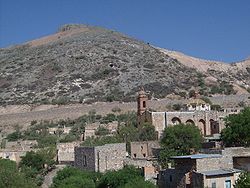- Cerro de San Pedro
-
Cerro de San Pedro is a town and municipality in the Mexican state of San Luis Potosí. The town started as a mining town for gold and silver. It was the founding town of the state, and its figure is prominent in the state's coat of arms. As of 2005[update], the population was 95.[1]
Contents
Location
The village is located in the central part of the state. The coordinates of the city center are 100º 49’ west longitude and 22º 13’ north latitude, and 2,040 meters above sea level. The city borders Soledad de Graciano Sánchez on the north and west, Armadillo de los Infante on the east, and San Luis Potosí and Villa de Zaragoza on the south. It is also known as the "Pedro's Kiss."
History
In 1583, in the town of Mesquitique, Brother Diego de la Magdalena met with some of the Guachichil natives. Among them was one named Cualiname or Gualiname, who called their attention to golden outlines in their face paintings. The friar asked him where he had obtained this pigment. The native told him that there was much of the powder to the east of their present location.
Brother Diego told Brother Francisco Franco about this discovery, who told Captain Miguel Caldera, who took possession of the place. Captain Caldera sent Gregorio de León, Juan de la Torre, and Pedro de Anda to prospect for minerals. The latter named the place San Pedro del Potosí, to honor his namesake saint and in memory of the famous mines of the Potosí in Alto Perú, today Bolivia.
In and around the hill was much gold and silver, but there was not enough water to make it worth mining. The nearest water was towards the north, in a region still dominated by several native Chichimeca tribes, and where the city of San Luis Potosí would later arise. The historian Primo Feliciano Velázquez y Basalenque included extensive descriptions of the place in his accounts.
Contemporary history
The mines were operated by, among other companies, Metalúrgica Mexicana, ASARCO. During its time, a mining strike was called (1948), which was lost by the miners; the company decided to leave, not before collapsing the main shafts and tunnels. The mines were never declared exhausted.
Towns
This Municipality includes several towns and some colonies, as follows:
- Cerro de San Pedro (Cabecera Municipal)
- Portezuelo
- Real del Potosi
- Monte De Caldera
- Cuesta de Campa
- La Zapatilla
- Divisadero
- Calderon
- Jesus Maria
- Joyita de la Cruz
- La Florida
- Granjas de San Pedro
- Granjas de la Florida
- Planta del Carmen
Names of selected mines
La Descubridora, San Pedro Celestial, Bisnagas, Barreno, Socavon Aventurero Mina la Victoria,5 de Mayo, San Pedro el Alto, San Pedro el Bajo, Catillas (located on Bufa Hill), Begonia, Socavon del Rey, Dorotea, La Encantada, La Flor, Tiro San Pedro, Tiro Juarez, Cañon de las Mulas, Salon Colorado
Main shafts
San Pedro shaft, Juarez shaft, Begonia shaft
References
- ^ Instituto Nacional de Estadistica y Geografia (2005). "Cerro de San Pedro, San Luis Potosi". Retrieved 6 April 2009.
Coordinates: 22°13′N 100°49′W / 22.217°N 100.817°W
San Luis Potosí, SLP (capital) Municipalities
and
municipal seatsAhualulco · Alaquines · Aquismón · Aquismón · Armadillo de los Infante · Axtla de Terrazas · Cárdenas · Catorce · Cedral · Cerritos · Cerro de San Pedro · Charcas · Ciudad del Maíz · Ciudad Fernández · Ciudad Valles · Coxcatlán · Ebano · El Naranjo · Guadalcazar · Huehuetlán · Lagunillas · Matehuala · Matlapa · Mexquitic de Carmona · Moctezuma · Rayón · Rioverde · Salinas de Hidalgo · San Antonio · San Ciro de Acosta · San Luis Potosí · San Martín Chalchicuautla · San Nicolás Tolentino · Santa Catarina · Santa María del Río · Santo Domingo · San Vicente Tancuayalab · Soledad de Graciano Sánchez · Tamasopo · Tamazunchale · Tampacan · Tampamolón Corona · Tamuín · Tancanhuitz de Santos · Tanlajás · Tanquián de Escobedo · Tierra Nueva · Vanegas · Venado · Villa de Arista · Villa de Arriaga · Villa de Guadalupe · Villa de La Paz · Villa de Ramos · Villa de Reyes · Villa de Hidalgo · Villa Juárez · Xilitla · Zaragoza
 Categories:
Categories:- Populated places in San Luis Potosí
Wikimedia Foundation. 2010.


